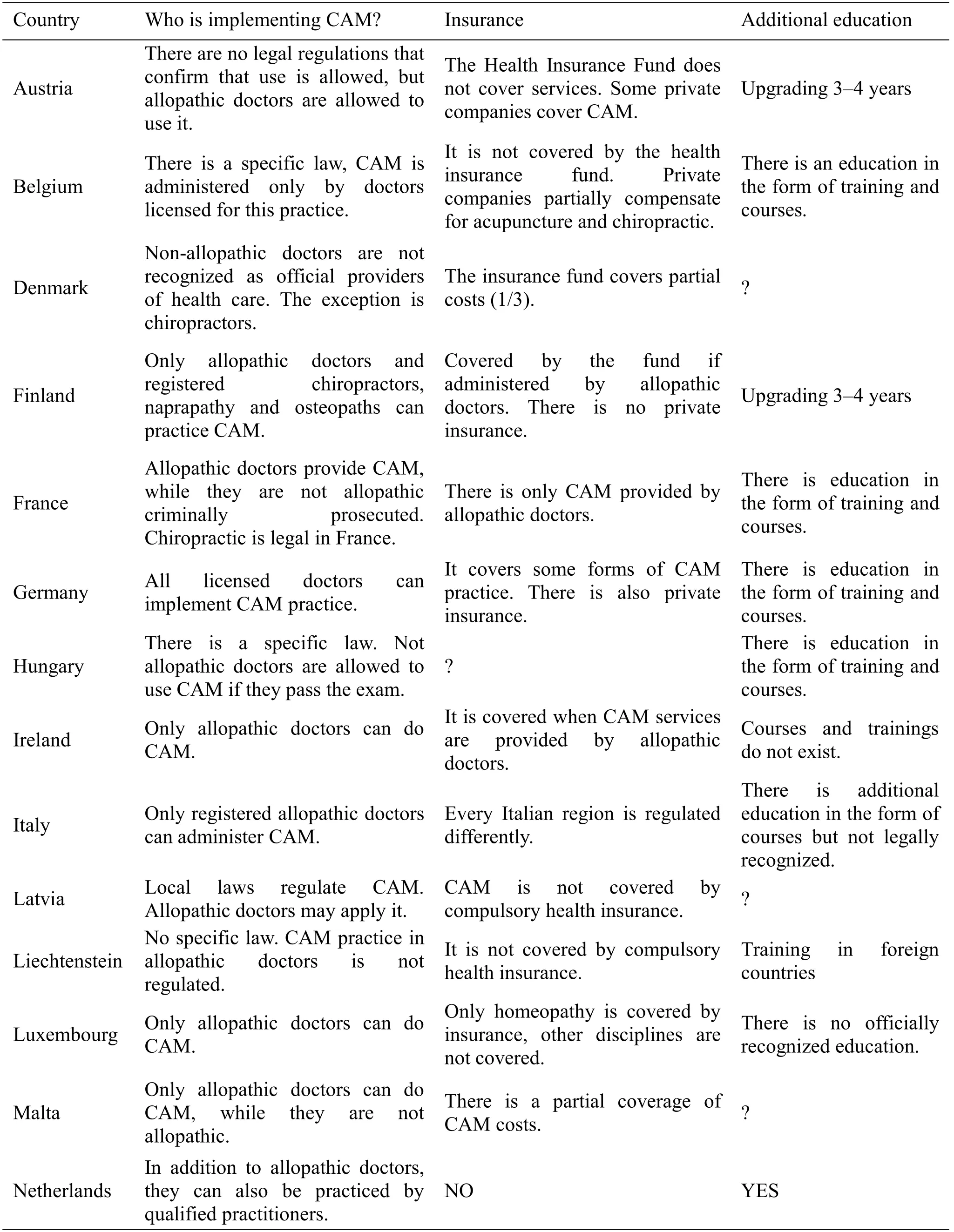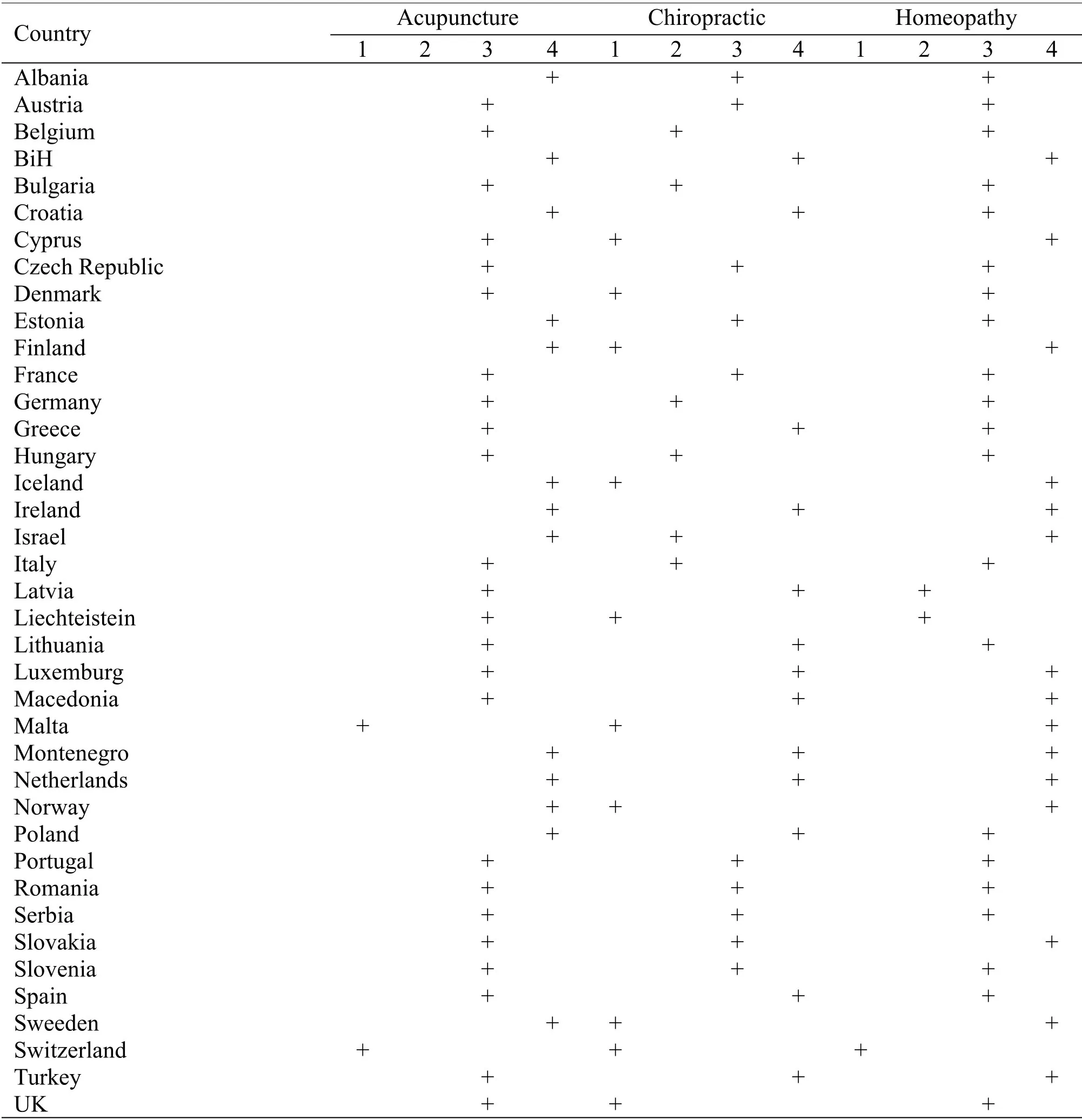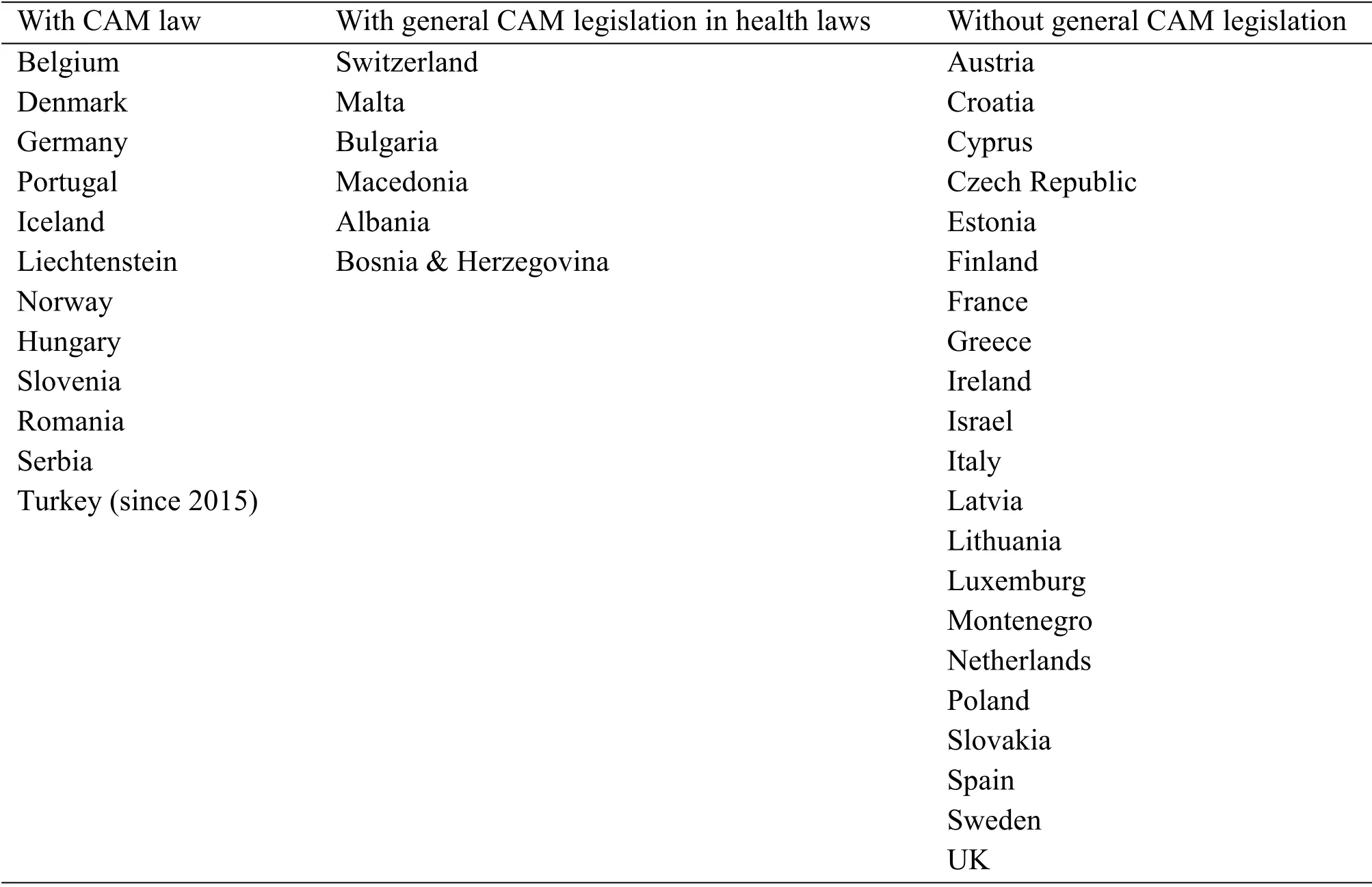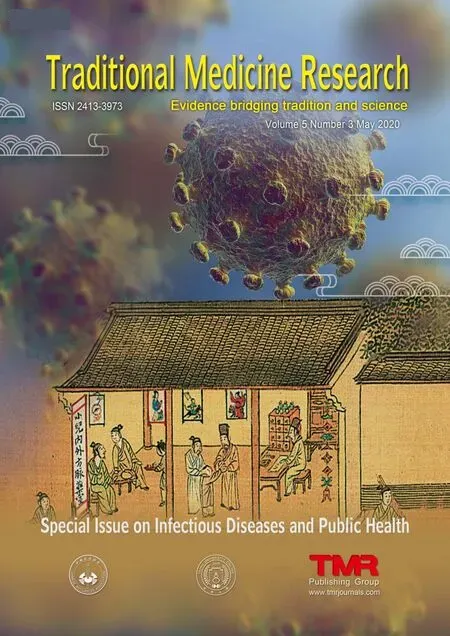Complementary and alternative medicine in European countries—legislative framework
Jovana Milenkovic,Sergey Bolevich,Gvozden Rosic
1Department of Dentistry,Faculty of Medical Sciences,University of Kragujevac,Kragujevac 34000,Serbia.2Department of Human Pathology, I.M.Sechenov First Moscow State Medical University (Sechenov University), Moscow 119991, Russia.3Department of Physiology,Faculty of Medical Sciences,University of Kragujevac,Kragujevac 34000,Serbia.
Abstract
Keywords: Complementary and alternative medicine, European countries, Methods of therapy, Legal status,Regulation,Legislation
Background
Since ancient times, various medical and non-medical healing practices have been used for providing general health and well-being of people.Today, various alternative methods of treatment, derived from previously known traditional methods, are enriched with modern scientific knowledge and known as complementary and alternative medicine(CAM)[1].
CAM presents a set of different diagnostic and therapeutic procedures, as well as the use of natural products for the treatment of patients.They are used as supplemental therapy with standard forms of medical treatment, but also for rehabilitation and prevention of certain conditions and diseases.The term complementary medicine points to the possibility that certain complementary systems are used as a supplement to the well-established medical therapeutic procedures,while the term alternative medicine is used to state that the methods of therapy differ from and are not applied as methods in modern medicine.There are insufficient evidences for the efficacy and safety of these methods and for this reason,they are labeled and critically known as CAM[2].
CAM can be provided by medical personal whose knowledge of the methods was acquired through medical education, but also can be provided by non-medical person whose knowledge was obtained from generation to generation or through courses that are differently regulated.In some countries, there is a legally regulated law that states that CAM courses can only be completed by health care providers (doctors,dentists, pharmacists), while a small number of countries even registered certain alternative methods as a profession,regulated by higher education[3].
CAM implies health practice, beliefs, approaches and knowledge relating to plant-based products,spiritual therapy, manual techniques and exercises for the purpose of treatment, diagnosis and prevention of disease.A holistic approach is a key element of any CAM method.Holism implies a universal understanding that the organism in the psychological,physiological and social sense should be viewed as a whole.Although they are often different from modern scientific knowledge in both the interpretation of the signs and symptoms of the disease and the course of treatment, CAM is effectively used alongside modern medical practice.In CAM, the emphasis is on the balance and the harmony of the individual [4].This type of treatment is based on the needs of the patient and must be individual in order to fully correspond to the current patient's condition.The most common alternative methods are traditional Chinese and Indian medicine, while in the west the dominant alternative methods are acupuncture,naturopathy and homeopathy[5].The aim of this article was to review the available data regarding the use of the CAM and the legislation behind it in European countries.
The most used methods of CAM
Traditional Chinese medicine
Traditional Chinese medicine (TCM) is a system of diagnostic and treatment methods developed around 4-5 thousands years ago [5].TCM is still being used today, primarily in East Asia.Due to the lack of understanding the influences of these therapeutic methods, TCM is less used in Western countries [6].The foundation of TCM holds the theory of“opposition forces”,Yin and Yang, which are believed to be connected with the energy of “Qi” (a vital force forming part of any living entity in traditional Chinese culture).The principle of Yin and Yang is the fundamental concept of Chinese philosophy and culture that dates back to the 3rd century B.C.E.This principle implies that all things exist as a blend of inseparable opposites.Two opposites attract and complement each other.Neither side is superior to another, but an increase of one contributes to the reduction of another.The right balance has to be achieved in order to achieve harmony.Yang is a male principle, while Yin is a female.In TCM, all physical processes,signs and symptoms can be categorized into Yin and Yang.The basic task of TCM is to establish a balance of previously disturbed Ying and Yang, or,when interpreting this statement through the modern medical understanding, to stimulate the immune system and to establish homeostasis [7].TCM treats individuals based on a holistic approach, comparing the differentiation of syndromes, which is a comprehensive analysis of the health status of individuals according to Yin Yang theory.Symptoms are used for the syndrome differentiation,however,the treatment of TCM is based on disease pattern differentiation of the syndromes rather than on one symptom.Therefore, people with various diseases causing the same syndrome would be treated in the same way, while persons with the identical disease would be treated in different ways depending on their syndromes.Western medicine, in contrast to TCM,focuses on the disease treatment after proper diagnosis based on the symptoms of a disease.TCM is involved within the Chinese health care system, and is differently available to the global population.It is estimated that more than 90% of the urban and rural population in China have at least once in their life,requested or used TCM[8].
Indian traditional medicine
India is a country with an extremely rich history of alternative medicine.Throughout history, six alternative medicine systems existed of which Ayurveda is the oldest, most widely accepted and the most practiced method.Ayurveda is also one of the most famous traditional methods of alternative medicine that survived since ancient times.It bases its principles on “all life-forms and the natural way of living”.Human life and health are looked at and analyzed through the unity of the body,mind and spirit[9].In therapy, Ayurveda includes procedures, the use of medicinal herbs, meditation, diet, breathing exercises and specific breathing techniques.Ayurveda procedures in India are applied in treatment of various diseases such as neurological, cardiovascular, diabetes and others.However, clinical studies that confirm the success of these procedures are missing.Ayurveda emphasizes the early detection of imbalance in the body.This aspect of disease prevention in Ayurveda is considered critically important.It also emphasizes the importance of mental or spiritual health.One of the basic approaches in Ayurveda is that even though the person is physically cured, the disease returns if a person does not find spiritual healing.Practices of Ayurveda commonly include the use of substances of natural origin, which includes herbs, preparations of etheric oils and minerals in the form of tea,capsules or tablets, alone or in combination.The good physical condition of body is of great importance for the over health of body and mind, and can be acquired with proper diet,exercises,meditation and yoga[10].
Homeopathy
Homeopathy is an alternative method practiced in Europe, Asia, and South America for mild diseases.In addition to acupuncture, it is one of the most commonly practiced alternative medicine methods[11].It was developed in Germany, by the teachings of a German physician - Samuel Christian Hahnemann(1755-1843 C.E.).It quickly spread from Europe, to North and South America and Australia.Today, it is used in over 30 countries.Homeopathy methods are used in hospital care in Europe.The principle of action,is that drugs and substances of plant and animal nature are used and tested on healthy volunteers in order to record developing specific symptoms.The theory being, a substance that causes certain symptoms of a disease in healthy people will cure opposite symptoms in the case of the illness.The treatment involves examining all aspects of the patient's medical condition,which implies physical, mental and emotional state [5,12].
Homeopathy uses diluted substances for the treatment of various disorders and illness.Today it is extremely popular and over 200 million people take homeopathic medicines.Health systems involving this method in countries such as Switzerland, India,Mexico, Brazil, Pakistan.Switzerland has the most developed homeopathy incorporated into their national health system, followed by the United Kingdom (UK)and Norway[13].
Acupuncture
Acupuncture is a method of CAM that dates back to 3,000 years ago.The beginning of this method is recorded in China.It was introduced into Korea and Japan in the 6th century B.C.E.and in the 16th and 17th century it migrated to Europe and North America[14].The therapy is carried out by trained practitioners who insert filiform needles subcutaneously and even deeper into muscle and tendon tissue to stimulate specific points on the body, the so-called trigger zone.The method is based on the fact that stimulation of certain trigger points can stimulate the release of endorphins, as a natural medication and pain reliever[11].Acupuncture analgesia was used in treating acute and chronic pain, especially in musculoskeletal and connective tissue disorders/illness.Acupuncture is used to treat headaches and achieves great success in the treatment of migraine.This method has long been used in symptoms of allergic diseases.Clinical results are showing that acupuncture is effective in eczema, it can decrease the susceptibility and itching.The effectiveness of the method shows equivalent effect to the use of oral antihistamines.Acupuncture could significantly improve the quality of life in patients with seasonal allergic rhinitis and reduce the use of antihistamines [15, 16].It has also been noted to assist in osteoarthritis therapy,but efficacy has not been fully proven[17].
Naturopathy
Naturopathy is a discipline that uses appropriate nutrition to achieve optimal health and manage many diseases.It is the youngest method, created at the end of the 19th century in America[5].In the 21st century,the culture of healthy life style and proper diet and nutrition are adopted, so many naturopathic principals have been developed.There are six basic naturopathic principles that are used in North America but these principles are not uniformly accepted by other naturopaths.These principles are: health is the power of nature, identification and treatment of the cause of the disease, the concept do not harm first, the therapist is a teacher, treatment of a complete individual and prevention.All of these principles point to a timely and accurate diagnosis, finding the cause and acting on it.The organism should be viewed as a whole and the treatment must include a complete analysis of the individual and not just action on the causative agent.In doing so, one should not forget the basic goal,primarily not to harm the patient.
The difference between nutritionists and naturopaths is that nutritionists are required in the public health system while naturopaths are exclusively represented in private practice [18].It is most commonly used in the United States (US), Europe, Canada and Australia.Naturopathic practitioners rely on natural healing,rather than introducing substances to fight disease.They try to restore healthy and normal functioning of the organism.Symptoms are used to determine the causes and nature of the disease and then determine the treatment.Therapy is complex and takes various forms of diets, herbs, hydrotherapy, massage and healthy lifestyle.The opinion and the advice of a medical doctor with a combination of this treatment protocol seem to be the most appropriate approach used by patients[19].

Table 1 Percentage of CAM usage in different European countries
Reflexology
Reflexology is a method of massage therapy,discovered in ancient Egypt [20].It implies a certain pressure on the target points on the foot usually,less so on the palms and ears.There are the so-called reflex zones in those body parts that can represent a map of the body.It is based on the principles of CAM,also on the energy flow through the body.Stimulation and the release of blockages, tension and knots bring healing.Many people are choosing reflexology for the method of solving health problems.The main advantage is safety, lack of significant side effects and not require the use of medication and supplements during treatment.It is especially useful in the relief of stress,since it is known that stress significantly contributes to disease development by up to 80%.It is generally not used in diagnostics.The objective of stimulation and massage of a particular body parts by bringing the relaxation of the target region and relaxation of the entire organism[21].
Use of CAM in Europe
CAM has been used since ancient times, but their use has dramatically increased in many countries in recent years.Early research has shown that the use of CAM in the US has increased significantly between 1990 and 1997, from 25% to 42% of the total population, with people admitting to at least one use of CAM.Surveys show increasing interest and confidence in the methods and practitioners of CAM [22].Since CAM is widely used, it is considered that the prevalence of CAM use is from 9.8 to 76%.It is important to note that 80% of the population in Africa and Asia rely on CAM in primary health care, regardless of the accessibility of modern medicine and medical products (jumping to 90% of the Indian polulation) [23].The Indian government is striving to actively use traditional medicine and homeopathy in national health programs and primary health care[24].
The increase in CAM usage has been recorded in Western countries and the rate of utilization from year to year is considerably higher[25].The use of CAM is recorded in countries throughout Europe and it is known to vary between 10 and 70% of the population[26].At least 300,000 registered CAM providers have been identified in the European Union (EU), of which slightly more than half includes non-medical practitioners, the rest are medical doctors who provide CAM services.The most affordable discipline is acupuncture.Acupuncture is provided by medical(80,000) and non-medical practitioners (16,380).It is followed by homeopathy with 45,000 medical and 5,800 non-medical practitioners.Anthroposophical medicine and neurotrophy are mainly provided by the doctors of medicine, while on the other hand, herbal medicine and reflexology are almost exclusively provided by non-medical practitioners[26].
The prevalence of CAM use is different in each country and is shown in Table 1.The most common diseases to use CAM are musculoskeletal problems,respiratory infections, urinary tract infections, allergies and psychiatric disorders[27].
The reason for the growing interest in CAM is generally considered to be insufficient care from allopathic medical practitioners and the fact that for some diseases modern scientific medicine has no valid solutions.Other reasons why CAM is increasing is that CAM methods generally cost less than modern medicine methods.Healthcarecosts are enormous in the 21st century and therefore people who are not covered materially turn to traditional methods.CAM is also on the rise because traditional medicine practitioners generally give more of their time to their patients and clients.By listening to patients and payingattention to them, CAM practitioners are gaining more trust.Because of the clinical success of CAM therapies leading to patient satisfaction,the increase in the use of CAM is significant[28].

Table 2 Who can use CAM?

Table 3 The status of acupuncture,homeopathy and chiropractic in different European countries.
CAM regulation and legislation
The European Parliament clearly indicates that any non-conventional medicine must be clear and precisely identified and defined.Similarly, the EU proposes that each member state should establish, organize and regulate its health system to compulsorily include CAM[29].
There are three types of CAM regulations:
(1) Exclusive licensing regimes—This kind of regulation is usually self-regulation delegated by the government.The rights to implement CAM are given to practitioners with a license, while practitioners without a license are illegal.
(2) Official certification—Certified practitioners are practicing CAM, usually under the self-regulation regime delegated by the government.Uncertified practitioners are not excluded, they can practice on specific domains but under certain labels.
(3) Voluntary private certification regimes—They are managed by private professional associations[30].
CAM regulation and legislation in Europe is not precisely defined and is constantly striving to find a common approach.Since there is no common approach and legal frameworks are not defined, each European state has its own regulations and legislation.This results in significant diversity in regional,national,European and international legal regulations.Unlike CAM, plant products are regulated in a similar manner in each country [31].In order to advance future research, this diversity in regulation and legislation,which creates a serious problem, should be summarized and precisely defined.Adequate regulation and supervision of CAM practitioners and therapies are of great importance and require special knowledge in the field of CAM, in order to take into account,the specificities of this domain of health care.
Due to the extreme distribution and increasing use of non-conventional medicine, it would be inadequate for CAM legislation to be regulated by adapting the criteria of conventional medicine only [32].Previous research has shown an exceptional diversity in terms of who can apply CAM practice, whether there are courses and different trainings that would allow the non-allopathic doctors to acquire the appropriate knowledge and skills to put a certain method into practice and thus help patients, which was the main goal of any type of medicine.Some countries cover the health insurance fund for CAM services and in some there are private insurance companies that compensate for certain CAM disciplines [24].Table 2 shows who can conduct CAM, which countries are covered by insurance and whether there is additional education for CAM methods.
More than 4000 doctors, physiotherapists and other health workers in the UK use acupuncture regulated by the statute.Also, about 2000 medical practitioners apply the method of acupuncture, although the process of legal regulation continues.In addition to these two groups, there are countless completely unregulated practitioners.The homeopathic practice is not regulated in the UK - anyone can be described as a homeopath [33].The interest of patients from Europe,the US and Australia has led to a significant increase in the use of CAM.Such a significant increase in the use of CAM resulted in insurance coverage for some therapies[34].Table 3 describes the regulation of CAM methods(acupuncture,homeopathy and chiropractic).
An economic overview of the implementation of CAM legislative framework
Interest in CAM has increased in the last few years and the general population attitude towards CAM is generally positive.People with multiple chronic conditions are increasingly using CAM, so it is expected that the use of CAM in the coming years will increase even more [35, 36].As a result of wider use,CAM is increasingly incorporated into medical education.
Due to the non-exigent definition of terminology,regulation and legislation, it is difficult to precisely define global costs for CAM.However, previous studies have shown that a significant amount of money is spent out-of-pocket on CAM[36].The beginnings of CAM are recorded in China [6], and China is a state that seeks to finance comprehensive health care in the coming years [37].The development and creation of modern medicine was extremely expensive.The formation of new medical technology, education and the creation of a professional staff resulted in the creation of extensive medical networks of funding,and the pooling of social and private insurance with the personal funding of patients.By 2020, most people in the world will live in countries that have regulated the comprehensive status of national systems that provide and finance health care [38].Today, CAM is increasingly incorporated into national health systems.In some European countries, public national insurance covers the cost of various CAM treatments and in some countries, there are private insurance companies that partially cover CAM costs.In order to precisely define the cost status and insurance of CAM, it is necessary to undertake new surveys that would include a detailed overview of the economic and health outcomes of the CAM treatment in order to cover the cost of their expenses[24,36].
CAMbrella is a project of the EU designed to find a unique system that would include the treatment of CAM in Europe.CAMbrella is a pan-European research network for CAM.The goal of this collaboration is to develop a roadmap for future European research in CAM that is appropriate for the health care needs of EU citizens and acceptable to the EU Parliament as well as national research funders and healthcare providers.It has enabled meaningful,reliable comparative research and communication in Europe.The goals are to develop an EU network that includes centers of excellence in research for collaborative research,then develop a consensus-based terminology widely accepted in Europe to describe CAM interventions to create a knowledge base that facilitates our understanding of patient demand for CAM and its prevalence, review the current legal status and policies governing the provision of CAMs in the EU and the EU to explore the needs, beliefs and attitudes of EU citizens in relation to the CAM.

Table 4 CAM legislation in different countries
Each of the 39 countries has done study of its own CAM approach [31].According to the data from CAMbrella, from 39 countries in the EU, 17 have general CAM legislation.Out of these 17 countries,11 have a CAM law and 6 states have parts of CAM health care law.Some countries have regulated specific treatments in addition to the general CAM regulation.CAM regulations and legislation are generally different for countries that have CAM law and countries with only specific CAM treatment regulated.Norway and Hungary have a general CAM law.However, in Norway CAM law is general and does not describe the specificity of the treatment itself and those who practice CAM.Hungary, on the other hand,also has CAM law,but it can be considered as an integral part of the health care system [29].In Table 4 there are the data of CAM legislation in different countries.
CAM is regulated in Germany since 1939.The protected title heilpraktiker is used for non-medical skilled practitioners and only doctors and heilpraktikers can practice CAM.Hungary has a clearly defined CAM status.CAM legislation has been integrated into the public health system and all CAM providers must be part of the official health system.In order to practice CAM practice, they must have a license.In Serbia, CAM has been regulated since 2005 and can only be applied by healthcare professionals,doctors, dentists, pharmacists and medical staff after appropriate education.In France,there is no CAM law,so only lawfully trained staff can treat patients and only medical-qualified experts practice CAM.The regulation of the Swiss system is decentralized.Legislative authority in the cantons is a unicameral parliament, and each canton has its own individual regulations.In Malta, only acupuncture, chiropractic,osteopathy and physiotherapy are regulated [39].In some countries, if CAM is applied without a license/permit, or if an unqualified person is applying,a fine or imprisonment is enforced.In Belgium, they shall be fined or suspended and in some cases the revocation of the CAM license.In Liechtenstein,a fine or imprisonment of 3 months is imposed on unqualified practitioners[24].
Prospective
The status of CAM in Europe has its own specificities.It is characterized by enormous heterogeneity in all aspects, starting with the terminology, method,prevalence and ultimately legal status, regulations and legislation.CAM regulations and legislation are expressed differently from country to state and sometimes there are differences in multiple regions of the same country.Due to this heterogeneity, access to CAM research is difficult for the EU[40].Therefore,it is important to carry out harmonization, to precisely define the methods, regulation and legislation of the CAM.Voluntary harmonization is possible under the existing legislation.It is important to encourage countries within culturally similar regions to harmonize CAM legislation.For example,the status of a physiotherapist is regulated and recognized throughout Europe and it is thought that this can be done for CAM.Physiotherapy has a long tradition as a recognized profession, with clearly defined attitudes and the importance and effect of physiotherapy treatment is described.Successful mutual recognition of physiotherapists throughout Europe shows how this can be done[41].
 Traditional Medicine Research2020年3期
Traditional Medicine Research2020年3期
- Traditional Medicine Research的其它文章
- Medical workers in traditional medicine who sacrificed their lives in the battle against COVID-19 deserve to be remembered forever
- Overview of the plague in the late Ming Dynasty and its prevention and control measures
- Network pharmacology studies on the effect of Chai-Ling decoction in coronavirus disease 2019
- The potential application of the traditional Chinese herb Exocarpium Citri grandis in the prevention and treatment of COVID-19
- The role of natural products in regulating pyroptosis
